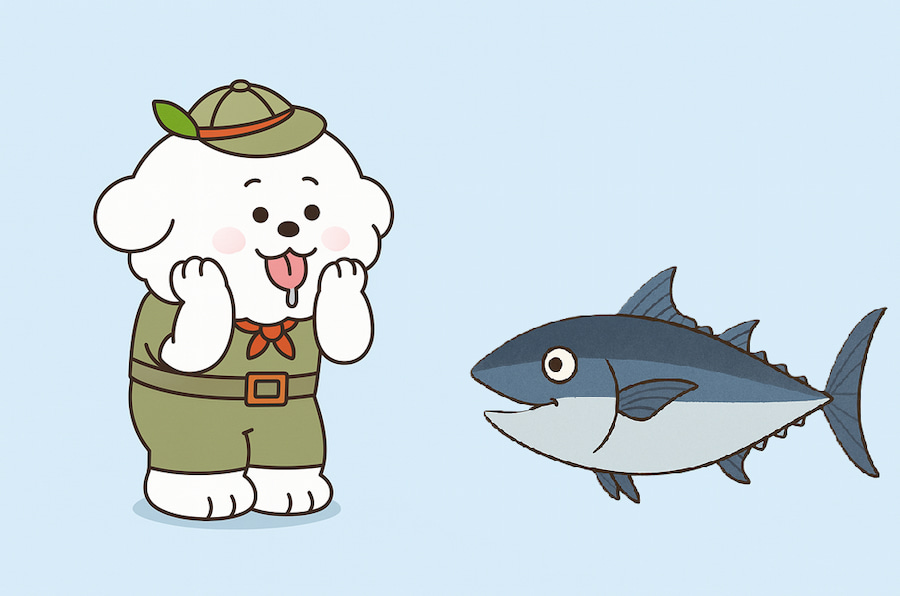Can dogs eat dried Pollock? It’s a question many pet owners ask me. The answer is yes, but only in moderation, and there are some precautions, too. Dried Pollock is a low-fat treat that is high in protein and omega-3 fatty acids. Dried Pollock is very beneficial for your dog’s heart, brain, skin, and fur health.
In this article, I’ll explain the exceptional nutritional benefits of Pollock fish for dogs, along with the precautions and different methods for feeding Pollock to your dog.
What is Dried Pollock?
Pollock is a whitefish that is protein-rich and loaded with omega-3 fatty acids. The pollock fish of Alaska is very famous. It is found in pristine Alaska waters. Wild Pollock is caught, and after removing the innards, it is hung in a windy seaside area where it freezes and thaws for 2 to 3 months during the cold winter, drying with the sea breeze to make tasty dried Pollock. This drying process preserves the nutrients of Pollock fish, and the final product is highly beneficial for dogs. The final dried pollock fish is converted into different bite-size treats, including dried pollock sticks.
The good thing is that this process of drying pollock fish doesn’t involve any additives or preservatives. There is no use of salt. So, this dried pollock fish becomes an excellent, delicious, and easy-to-digest chew for dogs.

Lee&Pol’s products combine nutrient-rich dried pollock with a variety of freeze dried fruits and vegetables, such as carrots or beets, to provide a more nutritious treat!
Can Dogs Eat Dried Pollock?
Yes, dogs can safely consume dried Pollock. Dried Pollock is a good source of animal protein, trace minerals, vitamins, and omega-3 fatty acids, including EPA and DHA omega-3 fatty acids. All these things are highly beneficial for your dog’s muscles, joints, brain health, heart health, shiny coat, and healthy skin.
However, remember that treats can’t be overfed. Although dried Pollock is low in fat, you can’t feed it excessively. Moderation is the key to offering treats to your dog.

Make sure that dried Pollock, along with any other treats, doesn’t exceed 10% of your dog’s daily diet.
Is Dried Pollock Good for Dogs?
Dried pollock fish has excellent benefits for our furry friends. It can benefit your dog’s brain, heart, skin, and fur. Pollock fish is rich in protein and omega-3 fatty acids. Dried fish is also tasty for dogs because it seals in the raw fish flavor and nutritional value.
Pollock for dogs also has anti-inflammatory properties, so it is beneficial for dogs suffering from joint issues or skin issues.
Benefits of Dried Pollock for Dogs
Benefits of dried pollock fish include:
1. Low-Calorie Treat
Dried fish is low in calories, and that means you can offer this a bit more to your dogs compared with many other high-caloric dog treats. This can be very beneficial for dogs who are struggling with weight loss. By offering dried pollock fish to obese dogs, you can offer delicious treats to your dog without worrying about weight gain.
2. Low in Mercury
Before feeding any fish to your dog, you should always consider the levels of mercury in that specific fish. High mercury levels can damage the heart muscles of dogs. Pollock fish have low levels of mercury compared with many other fish, and that’s why they are suitable for dogs. According to the FDA, maximum mercury levels in Pollock fish are 0.78 PPM compared with tuna (1.81PPM), shark (4.54PPM), swordfish (3.22PPM), and tilefish (3.73PPM). You should avoid fish from the Gulf of Mexico, like tilefish because they usually have higher mercury concentrations.
Mercury levels are usually higher in large fishes like sharks because they have a longer lifespan and eat many small fish. That’s why mercury levels keep increasing in these fish. You should always prefer small fish with short lifespans to avoid high levels of mercury.
3. High in Protein
Pollock fish is very rich in protein, which is important for dogs’ health. Protein contributes to the development of muscles, bones, and connective tissue. It also strengthens the immune system, which fights infections and diseases. And it may also help with patellar luxation, a common problem in dogs.
4. Low in Fat
Pollock fish is low in fat and a great crunchy treat for dogs battling obesity. Dried pollock fish can end your dog’s cravings for fresh, oil-cooked fish while providing awesome nutritional benefits.
5. High in Omega 3 Fatty Acids
Pollock fish also contains omega-3 fatty acids, including EPA and DHA omega 3 fatty acids. Omega 3 fatty acids are well known for a lot of benefits. They contribute to your dog’s shiny coat and healthy skin and eyesight. They also promote cardiac health and neurological functions. Omega 3s also reduces inflammation in the joints and muscles, which is good for active dogs.
6. Source of Iron
Pollock fish is also an excellent source of iron. Iron is an important mineral that helps your dog’s blood cells to carry oxygen to different parts of the body. Iron deficiency can cause the reduced production of red blood cells and hemoglobin (a protein responsible for carrying oxygen in RBCs). This can result in weakness and lethargy while playing or running.
7. Vitamin B12 and Selenium
Pollock fish is also a good source of vitamin B12 and selenium. Vitamin B12 strengthens the immune system, helps with digestion, and makes DNA. Selenium also strengthens the immune system.
8. Easily Digestible
Pollock is easy for your dog to digest, especially if you have an senior dog. It is much easier for your dog’s digestive system to digest than red meat.
9. Dental Cleaning
Chewing crunchy and dried pollock fish can remove tartar and plaque from your dog’s teeth. This can lead to healthier teeth and gums and less accumulation of bacteria.

Lee&Pol’s products combine nutrient-rich pollock with a variety of fruits and vegetables to provide a more nutritious treat!

How to Feed Dried Pollock to Dogs?
So, you now have the answer to your question, “Can dogs eat dried pollock?”. Let’s have a look at some great ways to feed dried Pollock to your dog:
As a Reward or Treat
You can feed dried pollock fish to your dog as a treat or reward for obedience training. But keep in mind that treats count towards your dog’s total calorie intake. That’s why you should be careful about the quantity of treats you give to your dog. The golden rule is that treats should not exceed 10% of your dog’s daily caloric intake, and the remaining 90% should be a well-balanced dog food.
Mixed with Kibble
You can offer dried pollock fish as a whole, or you can cut it into small pieces and spread it over your dog’s kibble to make it more interesting and appealing for picky eater dogs.
Homemade Treat
Dried Pollock for humans contains salt because Pollock is a sea fish. However, an excessive amount of salt in dried Pollock meant for humans is not good for dogs because it can cause electrolyte imbalance and dehydration. If you want to offer your dried Pollock to your dog yourself, then follow the instructions below:
- First, soak the dried Pollock in water or rinse it under running water to remove the excess salt.
- After this, dry it again by leaving it for some time in a cool and dry place.
Precautions When Feeding Dried Pollock to Dogs
Follow the below precautions whenever giving dried Pollock to dogs:
1. Salt
Always check the label for added salt when buying dried Pollock treats and opt for dried Pollock without any salt content. However, Pollock is a sea fish and naturally has more salt content than freshwater fish. That’s why you should soak it in water or rinse it under running water to reduce the salt content. After rinsing Pollock under water, dry it again by leaving it for some time before feeding.

Salt can cause dehydration and electrolyte imbalance in dogs. This is especially dangerous for older dogs, who are already at risk due to their age and health condition. Excessive salt intake can also cause increased thirst, vomiting, diarrhea, and lethargy in dogs.
2. Fish Bones
Dried Pollock or fresh Pollock bones are not safe for dogs and can cause choking. Fish bones are small and brittle, and they can get stuck in your dog’s mouth, stomach, or intestines and can make things serious. You should be extremely careful when feeding either dried Pollock or fresh Pollock. Always remove the bones before feeding pollock fish to your dog to avoid any choking hazards.
3. Allergy
I have never had any cases of dried pollock allergy in dogs nor heard about any dogs with pollock allergy. But still, I suggest introducing dried Pollock slowly so that your dog can adjust to the new food. By offering small amounts at the start, you’ll also be able to rule out any allergies. If you ever see any sign of fish allergy, take your pet to the vet as soon as possible. Here are some signs of fish allergy in dogs:
- Itchy skin
- Vomiting
- Diarrhea
- Ear infection
- Excessive licking of feet
4. Monitoring
It is very important to monitor dogs who gulp their food. Dried Pollock is not suitable for dogs who gulp their food as it may pose a choking risk. Dried Pollock is meant to be chewed by dogs.
5. Quantity
How much dried Pollock you feed your dog is also important. Too much of anything can make things worse. Moderation is the key while feeding dried Pollock to your dog. Also, make sure that Pollock or any other treat doesn’t exceed 10% of your dog’s daily diet.
6. Avoid Farmed Fish
You should avoid farm-raised pollock fish because they have antibiotic residues. Fish farmers give antibiotics to avoid infections. Always opt for wild-caught pollock fish that is free from all types of antibiotics.

Lee&Pol use fresh and high-quality pollock, with a process of removing fish bones and desalting. So, you can feed your dog with confidence.
Conclusion
We can conclude that dried pollock fish is an excellent source of protein, essential minerals, vitamins, and omega-3 fatty acids for dogs. When given in moderation, pollock fish is highly beneficial for your dog’s brain, heart, skin, fur, muscles, and joints.
Pollock fish is low in mercury and fats, making it a perfect low-calorie treat for dogs with weight issues. Just avoid salty, farm-raised Pollock. Also, take special care of fish bones, as they pose a choking risk.
FAQ
No, fresh pollock bones, as well as dried pollock bones, are a choking hazard and should not be given to dogs. You should carefully remove the pollock bones before offering this fish to your dog.
Dried fish is better than fresh or cooked fish for dogs who are on a weight loss diet because cooked fish has more fat. Also, it is super convenient to store and carry dried fish. On the other hand, fresh fish can’t be stored for the long term.
You can store the dried pollock fish in an airtight container in a cool place. Avoid direct contact with sunlight, as the sun’s UV rays can damage the fish.
Yes, dogs can safely eat Alaskan Pollock. The pollock fish of Alaska is very famous, and it is abundant in Alaska’s waters.
No, you shouldn’t offer salted dried fish to your dog. The reason is that the high amount of salt can harm your dog because dogs cannot process high salt levels. Excess salt intake can result in dehydration, high blood pressure, vomiting, and diarrhea.
Pollack and Pollock are the same fish. Their names differ based on the area where they’re caught. Pollock is caught in Alaska, while Pollack is caught in the East Atlantic.



